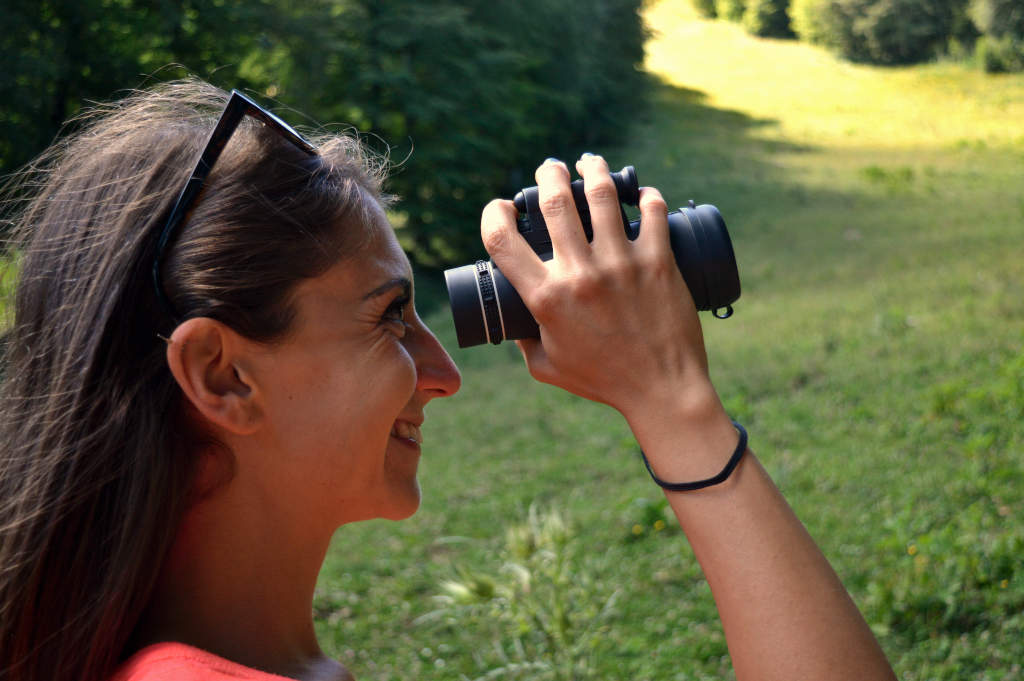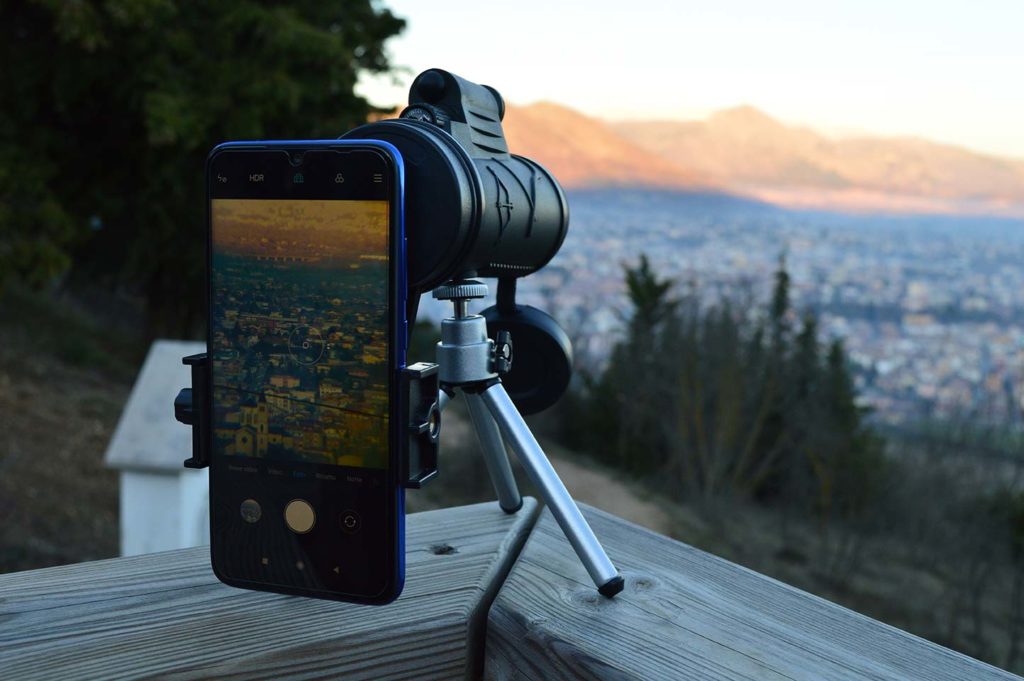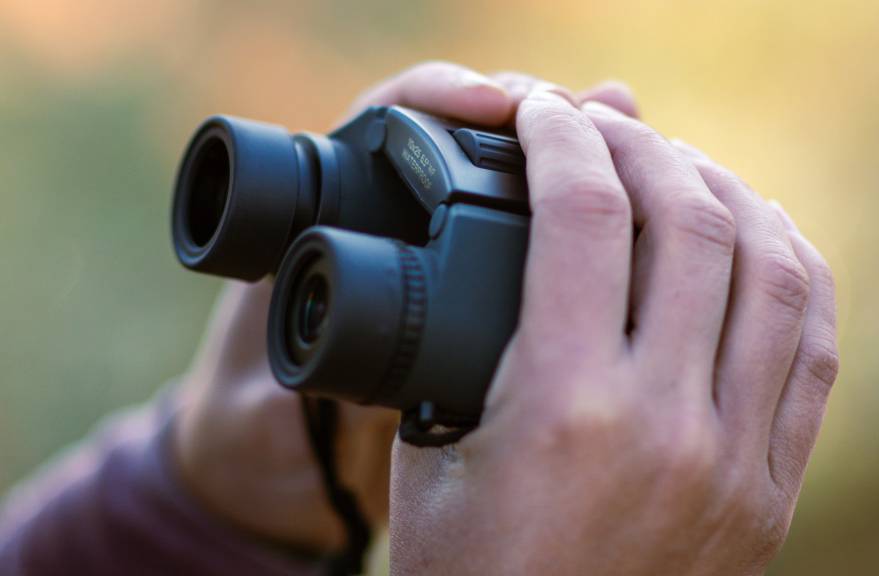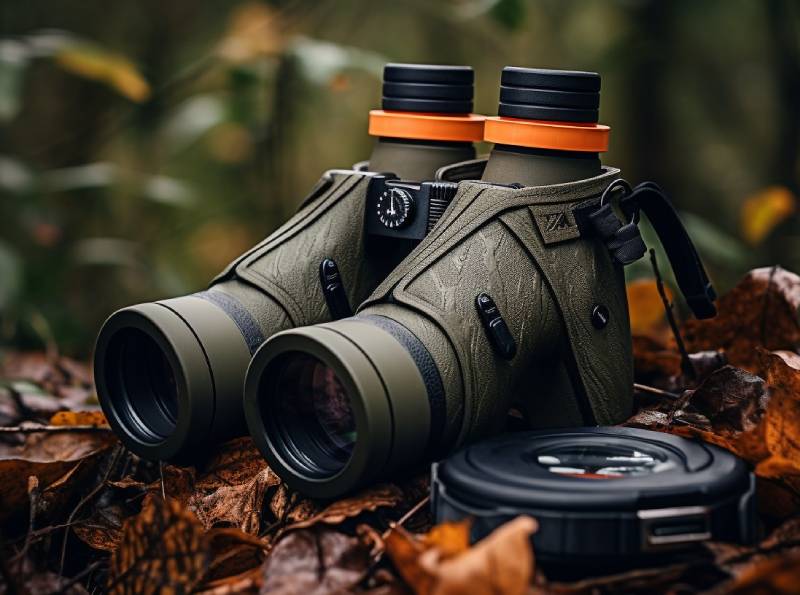 Monoculars technical description explained easily
Monoculars technical description explained easilyReading time 12 minutes
Monoculars and binoculars are designed to observe from a distance and, like any tool, have their own units of measurement and technical terms that may sound a bit difficult to grasp at the beginning. Actually, it’s not so complicated.
Whether it is out of curiosity, to cultivate a new passion or gather more information before purchasing, I am sure that at least once you wondered “What do the numbers that appear on the monocular mean?”
You can find different models such as 12×50 mm, 10×42 mm, 7×35 mm, but what do those numbers stand for?
In this post, you will learn the meaning of the numbers that appear on the monocular or binoculars, how to choose the most appropriate model, what are the features to consider, the main technical terms used by manufacturers and you will discover useful tips for professional observations.
Follow me.
WHAT DO THE NUMBERS ON THE MONOCULAR MEAN?
To distinguish different models of monoculars and binoculars, we can use two numbers: for example 12×50 mm or 10×42 mm.
The first number (usually called magnification) indicates the zoom, or how many times the observed images appear enlarged. A 12×50 mm monocular will show us the objects (or subjects) 12 times closer, while a 10×42 mm will have 10 times zoom.
The second number after the x is in millimeters and indicates the diameter of the objective lens. A 12x50mm monocular will have a 50mm diameter objective lens, while a 10x42mm will have a 42mm lens.
Easy, right? Let’s move on and look closer.
MAGNIFICATION
The magnification is the first number of the monocular and indicates how many times the images appear closer to our eyes.
The larger the magnification of the image = The smaller the field of view. What does it mean?
If the image appears bigger to our eyes, the field of view (the space to be framed) is narrower. When observing with the monocular, the vibrations of the hand can make the framed image unclear. With magnifications greater than 10x, you would better use a tripod to have a stable monocular as well as a clear and detailed observation.
On the other hand, if you are searching for a panoramic observation and focus on fewer details, choose a lower magnification.
LENS DIAMETER
The second number after the x indicates the diameter of the objective lens expressed in millimeters which determines the amount of light collected and the width of the field of view. This feature is important in low light conditions such as during sunset or twilight.
The larger the diameter of the lens = The more brightness and visible details = The heavier the monocular
The larger the lenses, the heavier the monocular (or binoculars). Usually monoculars with diameters not exceeding 50 mm are indicated for travel, excursions and outdoor activities, as they are lightweight and practical to carry. For trekking and day observations, a diameter of 20 mm is enough while for night observations, a diameter of 50 mm guarantees greater visibility.
LET’S MAKE AN EXEMPLE
What is the difference between a 10×42 mm and a 12×50 mm monocular?
In the first case, it is a monocular with a magnification up to 10 times and with an objective lens diameter of 42 mm. In the second case, it is a monocular that allows us to see 12 times closer and with a 50 mm objective lens.
By comparing the diameter of the objective lens, the second model will collect more light and the field of view will be wider than the first one. To maintain a more stable and clearer observation, in the second case we will need a tripod.
Understanding what the numbers that appear on the monocular mean is not enough. Follow me to discover other important features to consider.
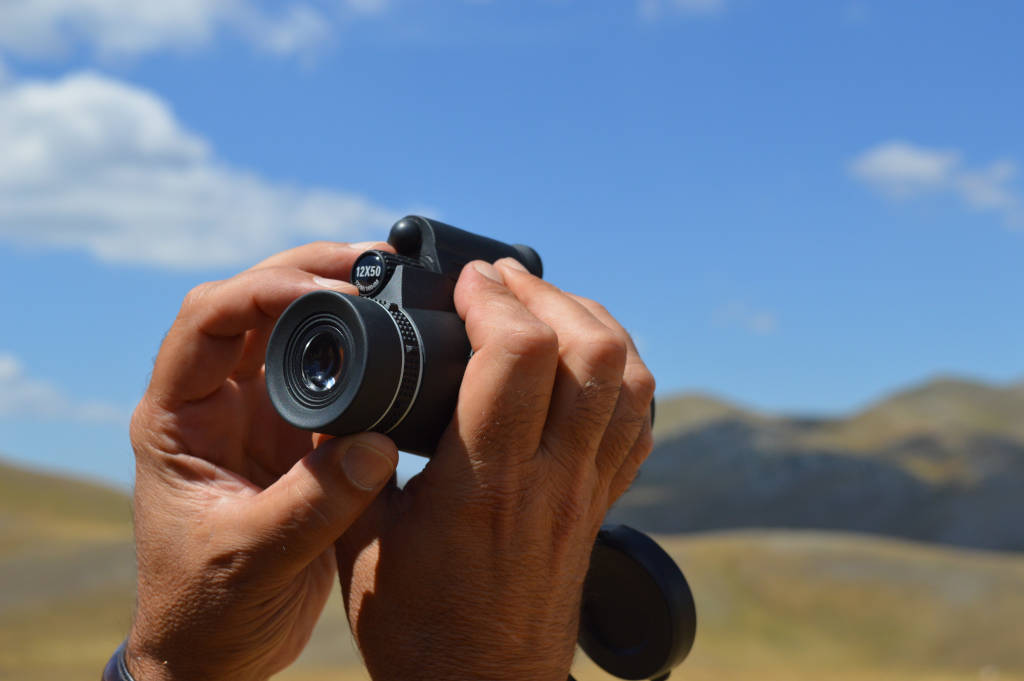
FIELD OF VIEW
The field of view represents the area that you can observe with a monocular (or binoculars) at a distance of 1000 meters (1 km). The unit of measure can be both meters and degrees.
Let’s make an example.
In the technical description of our monocular, you can read Field of view 122M / 1000 M, which means that at a distance of 1 km, you will be able to observe a field of 120 meters.
You may happen to read “Visual angle”, also in this case we refer to the area that we can observe with the monocular but this time expressed in degrees. We can calculate it with a mathematical formula where the factor 17.5 represents the visual field in meters corresponding to a visual field of 1 °.
- 1000 m field of view = Visual angle in degree x 17,5
- Visual angle in degree = 1000 m field of view/ 17,5
Let’s come back to our example: 12×50 mm monocular with 120 M / 1000 M field of view and apply both formulas to calculate the field of view and the angle of view.
- Field of view 1000 M = 6.85 x 17,5 = 120
- Visual angle in degree = 120 / 17,5 = 6.8°
In a nutshell, the monocular has a field of view of 120M / 1000M and has 6.8 ° of field.
The width of the field of view is inversely proportional to the magnification: a 10x monocular will have a greater field of view compared to a 12x monocular.
Greater magnification = Wider field of view
EXIT PUPIL
Another value to consider when buying a monocular is the exit pupil expressed in millimeters which indicates the diameter of the light beam that reaches the eye.
Exit pupil = Diameter of the lens / Magnification
Let’s come back to our 12×50 monocular, the exit pupil will be 4.5 (50/12). A common value for nitid images in the daylight and good images in low light conditions.
Let’s find the reason.
The exit pupil is a parameter to consider as it should be at least as wide as the pupil of our eye, which goes from 2 mm in bright light environment to 7 mm in low light conditions.
The greater exit pupil = The greater transition of light = The brighter the images
Now everything is clear. For night observations, it all depends on the values shown in the product description. The next time you will read the exit pupil value, you can get an idea if the monocular is also suitable for twilight or sunset observations.
EYE RELIEF
Eye relief is different from the exit pupil, although apparently the terms sound similar. Eye relief is the distance between the eyes and the lens of the monocular and goes from 5 to 20 millimeters.
Why you should know this value?
It is especially important for people who wear glasses to understand broadly if the model can fit. When we wear glasses, the eyes are further away from the lens and we risk losing the image. If the distance between the eyes and the lens (i.e. the eye relief) is greater than 17 mm, it means that even wearing glasses, the monocular will show you the same field of view.
The greater the eye relief = The better the observation with glasses
The ideal eye relief for those who wear glasses is 20 mm and is also perfect for viewing with the eye in order to observe clearly and blink.
For example, our monocular has a 20 mm eye relief and through the dioptric adjustment wheel, you can adjust the focus according to your myopia.
TYPES OF LENS
The lenses used for monoculars and binoculars can be made in:
– Plastic. They are appreciated for their impact resistance during extreme sports. The images that appear in the eyes are of lower quality, consequently, the price is cheaper.
– Glass. They are mostly used in professional monoculars and binoculars. They produce quality images and the price is higher. The glass reflects the light that comes from the outside but this phenomenon is minimized through an anti-reflective treatment on the lens. Abbreviations are used to distinguish the different types of treatment for better light transmission and ensure clear images:
- C (Coated): External lenses have been coated with a single layer of anti-reflection;
- MC (Multi Coated): External lenses have been coated with multiple layers of anti-reflective treatment to ensure a better light transmission;
- FC (Fully Coated): Both the prisms inside the monocular and the external lenses have been coated with a layer of anti-reflective treatment;
- MFC (Multi Fully Coated): Both the prisms inside the monocular and the external lenses have been coated with multiple layers of anti-reflective treatment for better light transmission and greater protection of the lenses from water, humidity, scratches and accidental falls.
Multi-layer FC and MFC coatings are better compared to a single layer and this also affects the higher cost of the monocular and binoculars.
HOW TO RECOGNIZE A PROFESSIONAL MONOCULAR?
In addition to magnifying distant objects and subjects, the quality of a professional monocular differs not only in the slightly higher price but also in the features that guarantee a clear and brilliant vision. The most common are:
- Lens with multilayer coating and anti-reflective coating
- Nitrogen filling between the lens to avoid fogging
- Diopter adjustment for observation with or without glasses
- Adjustable focus
- Waterproof and non-slip rubber
- Additional features that make it versatile (es. flashlight o laser)
- Accessories included such as tripods
“THE BEST MONOCULAR” IS NOT AN EVALUATION CRITERIA
On the internet, I often read phrases such as “The best binoculars” “The most powerful monocular”. I wonder, on what basis can monocular or binoculars be labeled as “better” or “powerful”?
I will tell you a secret: There are no objective factors to determine the ideal tool.
Each observation requires adequate magnification and there are some features to consider:
- Size of objects and subjects to observe
- Weight and size of the tool
- Type of use: professional, amateur, day-time, night-time
- Eventual accessories (e.g. lens caps, case, tripod)
- Price range
The next time you will read a technical product description, you will know what the numbers on the monoculars or binoculars mean as well as recognize the difference between a professional model and a toy model. But now let’s focus on the practical tips for observation.
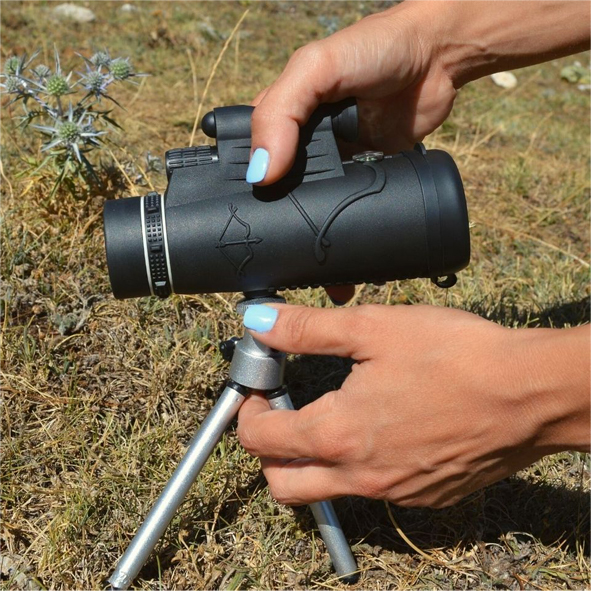
PRACTICAL TIPS
The higher the magnification = The heavier the tool = The more arm fatigue = The more visible the hand vibrations
So how to have a more stable and detailed vision?
Portable supports such as monopod or tripod are definitely the best solution to reduce hand vibrations. A foldable and small size tripod can make your observation pleasant and sharp.
Now you may wonder: “How can I do if I don’t have a support with me?”
Just think of professional photographers when shooting freehand: squeezing the elbows to the chest to limit the movements of the arm muscles, leaning on a hard surface (e.g. on a table, a fence, a rock, a wall or tree).
HOW TO READ A TECHNICAL DESCRIPTION EASILY
Let’s do a recap of all the points we have covered in this guide to read a professional product description and choose the suitable monocular.
- Magnification. The first number indicates how many times the images appear close to our eyes. For example, a 12×50 mm indicates a magnification of 12 times.
- Lens diameter. The second number indicates the diameter in millimeters of the frontal lens. It indicates the amount of light collected and the size of the field of view. In our example, the lens is 50 mm large.
- Field of view. It represents the area that you can observe with a monocular (or binoculars) at a distance of 1000 meters (1 km). A field of view of 122M / 1000M means that at a distance of 1km, you can observe a field of 120 meters. This point is important to consider if you want to have broad observations, such as during sporting events.
- Exit pupil. It indicates the diameter of the light beam (and consequently the brightness) that reaches the eye and this value varies from 2 to 7 mm.
- Eye relief. It is the distance between the eyes and the lens of the monocular and varies from 5 to 20 millimeters. An important value to consider especially for those who wear glasses.
- Types of lens. Glass lenses can have one or more layers of anti-reflective treatment. A higher number of layers ensure sharper vision.
No more secrets in the technical description of monoculars and binoculars. Even if you don’t try it physically, you already know what the numbers that appear on the monocular mean and all the features to consider for a model suitable for you. Now it’s your turn! Take a look at our 12 x 50 mm professional monocular.
Give yourself clear and bright observations to capture with your smartphone thanks to the universal holder included in the package.
We ship in Europe and in the package you will find:
- 12 x 50 mm professional monocular,
- Adjustable smartphone holder,
- Adjustable tripods,
- Pouch,
- Wrist strap,
- User’s manual.
Posts you may like:

